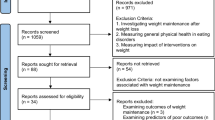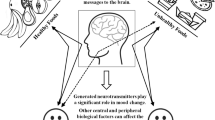Abstract
Objectives
We investigated the longitudinal association between depressive symptoms and glycemic control (HbA1c) in adults with type 2 diabetes, and the extent to which that association was explained by health behaviors.
Methods
This study assessed data on 998 adults (aged 51 and above) with type 2 diabetes in the US nationally representative Health and Retirement Study and its diabetes-specific mail survey. Participants’ depressive symptoms and baseline health behaviors (exercise, body weight control, and smoking status) were collected in 1998. Follow-up health behaviors and the glycemic control outcome were measured at a 2- and 5-year intervals, respectively.
Results
Nearly one in four of participants (23%) reported moderate or high levels of depressive symptoms at baseline (CES-D score ≥3). Adults with higher levels of depressive symptoms at baseline showed lower scores on baseline and follow-up health behaviors as well as higher HbA1c levels at a 5-year follow-up. Structural equation models (SEM) reveal that health behaviors accounted for 13% of the link between depressive symptoms and glycemic control.
Conclusions
The long-term relationship between depressive symptoms and glycemic control was supported in the present study. Health behaviors, including exercise, body weight control, and smoking status, explained a sizable amount of the association between depressive symptoms and glycemic control. More comprehensive diabetes self-care behaviors should be examined with available data. Other competing explicators for the link, such as endocrinological process and antidepressant effects, also warrant further examination.


Similar content being viewed by others
References
Cowie CC et al (2006) Prevalence of diabetes and impaired fasting glucose in adults in the U.S. population: National Health And Nutrition Examination Survey 1999–2002. Diabetes Care 29(6):1263–1268
Gavard JA, Lustman PJ, Clouse RE (1993) Prevalence of depression in adults with diabetes. An epidemiological evaluation. Diabetes Care 16(8):1167–1178
Anderson RJ et al (2001) The prevalence of comorbid depression in adults with diabetes: a meta-analysis. Diabetes Care 24(6):1069–1078
de Groot M et al (2001) Association of depression and diabetes complications: a meta-analysis. Psychosom Med 63(4):619–630
Lustman PJ et al (2000) Depression and poor glycemic control: a meta-analytic review of the literature. Diabetes Care 23(7):934–942
Lustman PJ, Clouse RE (2005) Depression in diabetic patients: the relationship between mood and glycemic control. J Diabetes Complicat 19(2):113–122
Gonzalez JS et al (2007) Depression, self-care, and medication adherence in type 2 diabetes. Diabetes Care 30(9):2222–2227
Wing RR, Phelan S, Tate D (2002) The role of adherence in mediating the relationship between depression and health outcomes. J Psychosom Res 53(4):877–881
Kilbourne AM et al (2005) How does depression influence diabetes medication adherence in older patients? Am J Geriatr Psychiatry 13(3):202–210
Sacco WP et al (2005) Depression in adults with type 2 diabetes: the role of adherence, body mass index, and self-efficacy. Health Psychol 24(6):630–634
Lin EH et al (2004) Relationship of depression and diabetes self-care, medication adherence, and preventive care. Diabetes Care 27(9):2154–2160
Lustman PJ, Griffith LS, Clouse RE (1988) Depression in adults with diabetes Results of 5-yr follow-up study. Diabetes Care 11(8):605–612
Lustman PJ et al (2005) Depression-related hyperglycemia in type 1 diabetes: a mediational approach. Psychosom Med 67(2):195–199
Egede LE, Ellis C (2008) The effects of depression on diabetes knowledge, diabetes self-management, and perceived control in indigent patients with type 2 diabetes. Diabetes Technol Ther 10(3):213–219
Peyrot M, McMurry JF Jr, Kruger DF (1999) A biopsychosocial model of glycemic control in diabetes: stress, coping and regimen adherence. J Health Soc Behav 40(2):141–158
Van Tilburg MA et al (2001) Depressed mood is a factor in glycemic control in type 1 diabetes. Psychosom Med 63(4):551–555
Ortega AN et al (2006) Co-occurrence of mental and physical illness in US Latinos. Soc Psychiatry Psychiatr Epidemiol 41(12):927–934
Pouwer F et al (2005) Serious diabetes-specific emotional problems and depression in a Croatian-Dutch-English Survey from the European Depression in Diabetes [EDID] Research Consortium. Diabetes Res Clin Pract 70(2):166–173
Trief PM et al (2006) Depression and glycemic control in elderly ethnically diverse patients with diabetes: the IDEATel project. Diabetes Care 29(4):830–835
Fisher L et al (2007) Clinical depression versus distress among patients with type 2 diabetes: not just a question of semantics. Diabetes Care 30(3):542–548
Fisher L et al (2008) A longitudinal study of affective and anxiety disorders, depressive affect and diabetes distress in adults with type 2 diabetes. Diabet Med 25(9):1096–1101
Katon W et al (2004) Behavioral and clinical factors associated with depression among individuals with diabetes. Diabetes Care 27(4):914–920
Katon WJ et al (2004) Cardiac risk factors in patients with diabetes mellitus and major depression. J Gen Intern Med 19(12):1192–1199
Vickers KS et al (2006) Patients with diabetes and depression may need additional support for exercise. Am J Health Behav 30(4):353–362
Ciechanowski PS et al (2003) The relationship of depressive symptoms to symptom reporting, self-care and glucose control in diabetes. Gen Hosp Psychiatry 25(4):246–252
Lerman I et al (2004) Psychosocial factors associated with poor diabetes self-care management in a specialized center in Mexico City. Biomed Pharmacother 58(10):566–570
Salmon P (2001) Effects of physical exercise on anxiety, depression, and sensitivity to stress: a unifying theory. Clin Psychol Rev 21(1):33–61
Juster FT, Suzman R (1995) An overview of the Health and Retirement Study. J Hum Resour 30:S7–S56 (special issue on the Health and Retirement Study: data quality and early results)
Radloff L (1977) The CES-D Scale. Appl Psychol Meas 1(3):385–401
Aalto-Setala T et al (2002) Major depressive episode among young adults: CIDI-SF versus SCAN consensus diagnoses. Psychol Med 32(7):1309–1314
Gigantesco A, Morosini P (2008) Development, reliability and factor analysis of a self-administered questionnaire which originates from the World Health Organization’s Composite International Diagnostic Interview—Short Form (CIDI-SF) for assessing mental disorders. Clin Pract Epidemol Ment Health 4:8
Hertzog C et al (1990) Measurement properties of the Center for Epidemiological Studies Depression Scale (CES-D) in older populations. Psychol Assess 2:64–72
Steffick DE (2000) Documentation of affective functioning measures in the Health and Retirement Study. In: HRS/AHEAD Documentation Report. Survey Research Center, Universtiy of Michigan, Ann Arbor, MI
Lee S et al (2005) Exercise without weight loss is an effective strategy for obesity reduction in obese individuals with and without Type 2 diabetes. J Appl Physiol 99(3):1220–1225
Barinas-Mitchell E et al (2006) Effect of weight loss and nutritional intervention on arterial stiffness in type 2 diabetes. Diabetes Care 29(10):2218–2222
Agurs-Collins TD et al (1997) A randomized controlled trial of weight reduction and exercise for diabetes management in older African-American subjects. Diabetes Care 20(10):1503–1511
Bloomgarden ZT (2006) Weight control in individuals with diabetes. Diabetes Care 29(12):2749–2754
Solberg LI et al (2004) Diabetic patients who smoke: are they different? Ann Fam Med 2(1):26–32
Wen CP et al (2006) Exploring the relationships between diabetes and smoking: with the development of glucose equivalent concept for diabetes management. Diabetes Res Clin Pract 73(1):70–76
Boule NG, Bouchard C, Tremblay A (2005) Physical fitness and the metabolic syndrome in adults from the Quebec Family Study. Can J Appl Physiol 30(2):140–156
Boule NG et al (2001) Effects of exercise on glycemic control and body mass in type 2 diabetes mellitus: a meta-analysis of controlled clinical trials. JAMA 286(10):1218–1227
Boule NG et al (2005) Effects of exercise training on glucose homeostasis: the HERITAGE Family Study. Diabetes Care 28(1):108–114
Sigal RJ et al (2007) Effects of aerobic training, resistance training, or both on glycemic control in type 2 diabetes: a randomized trial. Ann Intern Med 147(6):357–369
Ritzwoller DP et al (2006) Economic analysis of the Mediterranean Lifestyle Program for postmenopausal women with diabetes. Diabetes Educ 32(5):761–769
Graham JW, Tatterson JW (2000) Creating parcels for multidimensional constructs in structural equation modeling. Teaching report #00-41, The Methodology Center, Penn State University, USA
Graham JW, Hofer SM (2000) Multiple imputation in multivariate research. In: Little TD, Schnabel KU, Baumert J (eds) Modeling longitudinal and multiple-group data: Practical issues, applied approaches, and specific examples. Hillsdale, NJ, Erlbaum
Enders CK, Peugh JL (2004) Using an EM covariance matrix to estimate structural equation models with missing data: choosing an adjusted sample size to improve the accuracy of inferences. Struct Equ Model 11(2):1–19
Anderson JC, Gerbing DW (1984) The effect of sampling error on convergence, improper solutions, and goodness-of-fit indices for maximum likelihood confirmatiory factor analysis. Psychometrika 49:155–173
Marsh HW, Bajaj JR, MacDonald RP (1988) Goodness-of-fit indexes in confirmatory factor analysis: the effect of sample size. Psychol Bull 103:391–410
Marsh HW, Hau K, Wen Z (2004) In search of golden rules: comment on hypothesis-testing approaches to setting cutoff values for fit indexes and dangers in overgeneralizing Hu and Bentler’s findings. Struct Equ Model 11:320–341
Hu L, Bentler PM (1999) Cutoff criteria for fit indices in covariance structure analysis: conventional versus new alternatives. Struct Equ Model 6:1–55
Baron RM, Kenny DA (1986) The moderator-mediator variable distinciton in social psychological research: conceptual, strategic, and statistical considerations. J Pers Soc Psychol 51:1173–1182
Kline RB (1998) Principles and practices of structural equation modeling. Guilford, New York
Lustman PJ et al (1997) Effects of nortriptyline on depression and glycemic control in diabetes: results of a double-blind, placebo-controlled trial. Psychosom Med 59(3):241–250
Surwit RS et al (1986) Alprazolam reduces stress hyperglycemia in ob/ob mice. Psychosom Med 48(3–4):278–282
Lustman PJ et al (2000) Fluoxetine for depression in diabetes: a randomized double-blind placebo-controlled trial. Diabetes Care 23(5):618–623
Weber B et al (2000) Major depression and impaired glucose tolerance. Exp Clin Endocrinol Diabetes 108(3):187–190
Bjorntorp P, Holm G, Rosmond R (1999) Hypothalamic arousal, insulin resistance and Type 2 diabetes mellitus. Diabet Med 16(5):373–383
Drevets WC et al (2002) Glucose metabolism in the amygdala in depression: relationship to diagnostic subtype and plasma cortisol levels. Pharmacol Biochem Behav 71(3):431–447
Andrews RC et al (2002) Abnormal cortisol metabolism and tissue sensitivity to cortisol in patients with glucose intolerance. J Clin Endocrinol Metab 87(12):5587–5593
Orme CM, Binik YM (1989) Consistency of adherence across regimen demands. Health Psychol 8(1):27–43
Gonder-Frederick LA, Cox DJ, Ritterband LM (2002) Diabetes and behavioral medicine: the second decade. J Consult Clin Psychol Spec Issue Behav Med Clin Health Psychol 70(3):611–625
Acknowledgments
The authors acknowledge the grant support of National Institute on Diabetes and Digestive and Kidney Disorders. Grant number DK078894 (Linda A. Wray, PI). We acknowledge the valuable statistical consulting help provided by John W. Graham on an earlier version of this paper. The earlier version of this paper was presented at the Society of Behavioral Medicine’s 29th annual meeting on March 26-29, 2008 in San Diego, CA.
Author information
Authors and Affiliations
Corresponding author
Rights and permissions
About this article
Cite this article
Chiu, CJ., Wray, L.A., Beverly, E.A. et al. The role of health behaviors in mediating the relationship between depressive symptoms and glycemic control in type 2 diabetes: a structural equation modeling approach. Soc Psychiat Epidemiol 45, 67–76 (2010). https://doi.org/10.1007/s00127-009-0043-3
Received:
Accepted:
Published:
Issue Date:
DOI: https://doi.org/10.1007/s00127-009-0043-3




